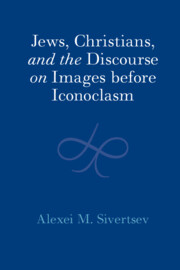117 results
Chapter 19 - Antiochene Riots against Jews in Malalas’s Chronicle
- from Part III - The People of Antioch
-
-
- Book:
- Antioch on the Orontes
- Print publication:
- 06 June 2024, pp 312-329
-
- Chapter
- Export citation
Chapter 20 - Speaking of Jews
- from Part III - The People of Antioch
-
-
- Book:
- Antioch on the Orontes
- Print publication:
- 06 June 2024, pp 330-342
-
- Chapter
- Export citation
Chapter 8 - Perfection
- from Part III - Transfiguration and Global Perfection
-
- Book:
- Human Perfection, Transfiguration and Christian Ethics
- Published online:
- 09 May 2024
- Print publication:
- 16 May 2024, pp 169-194
-
- Chapter
- Export citation
Judeopessimism: Antisemitism, History, and Critical Race Theory
-
- Journal:
- Harvard Theological Review / Volume 117 / Issue 2 / April 2024
- Published online by Cambridge University Press:
- 15 May 2024, pp. 368-390
- Print publication:
- April 2024
-
- Article
-
- You have access
- Open access
- HTML
- Export citation
Marginalised within a minority: Jews with disabilities in the Jewish press of the Kingdom of Poland (1860s–1914)
-
- Journal:
- Medical History / Volume 68 / Issue 1 / January 2024
- Published online by Cambridge University Press:
- 20 March 2024, pp. 60-85
-
- Article
-
- You have access
- Open access
- HTML
- Export citation
Jews and German Politics: The Case of Habsburg Moravia, 1867–1918
-
- Journal:
- Austrian History Yearbook , First View
- Published online by Cambridge University Press:
- 06 March 2024, pp. 1-19
-
- Article
-
- You have access
- Open access
- HTML
- Export citation

Jews, Christians, and the Discourse on Images before Iconoclasm
-
- Published online:
- 01 February 2024
- Print publication:
- 08 February 2024
8 - The Legacy of Max Sering and Inner Colonization
-
- Book:
- Frontiers of Empire
- Published online:
- 04 January 2024
- Print publication:
- 25 January 2024, pp 254-274
-
- Chapter
- Export citation
Introduction
-
- Book:
- Paul and the Resurrection of Israel
- Published online:
- 02 November 2023
- Print publication:
- 23 November 2023, pp 1-36
-
- Chapter
- Export citation
Chapter 5 - Regibus solo nomine regnantibus: The Late Merovingians
- from Part III - Dogs and Lesser Beasts
-
- Book:
- The Merovingians in Historiographical Tradition
- Published online:
- 02 November 2023
- Print publication:
- 16 November 2023, pp 225-271
-
- Chapter
- Export citation
Chapter 18 - Decolonizing the Medieval Literary Curriculum
- from Part IV - Canon Revisions
-
-
- Book:
- Decolonizing the English Literary Curriculum
- Published online:
- 02 November 2023
- Print publication:
- 09 November 2023, pp 349-366
-
- Chapter
-
- You have access
- Open access
- HTML
- Export citation
Introduction
-
- Book:
- The Early Christians
- Published online:
- 05 October 2023
- Print publication:
- 26 October 2023, pp 1-15
-
- Chapter
- Export citation
16 - Hebrew Sources
- from Volume II Part 1 - Literary Sources
-
-
- Book:
- The Cambridge History of the Mongol Empire
- Published online:
- 01 January 2024
- Print publication:
- 17 August 2023, pp 1261-1272
-
- Chapter
- Export citation
“Iranian Conditions: Health Problems and Medical Practices in the Words of the Staff of the Alliance Israélite Universelle, 1900–1950”
-
- Journal:
- Iranian Studies / Volume 56 / Issue 3 / July 2023
- Published online by Cambridge University Press:
- 05 June 2023, pp. 471-495
- Print publication:
- July 2023
-
- Article
- Export citation
Chapter 4 - Compliance and Defiance
- from Part I - Diplomacy and Politics
-
- Book:
- Vichy's Double Bind
- Published online:
- 18 May 2023
- Print publication:
- 01 June 2023, pp 77-97
-
- Chapter
- Export citation
Chapter 6 - The Menace Within
- from Part II - Local Encounters
-
- Book:
- Vichy's Double Bind
- Published online:
- 18 May 2023
- Print publication:
- 01 June 2023, pp 119-140
-
- Chapter
- Export citation
Chapter 8 - Confronting Italian Occupation
- from Part II - Local Encounters
-
- Book:
- Vichy's Double Bind
- Published online:
- 18 May 2023
- Print publication:
- 01 June 2023, pp 160-185
-
- Chapter
- Export citation
COVID-19 mortality among Jews in 2020: a global overview and lessons taught about the Jewish longevity advantage
-
- Journal:
- Journal of Biosocial Science / Volume 56 / Issue 1 / January 2024
- Published online by Cambridge University Press:
- 15 May 2023, pp. 15-35
-
- Article
- Export citation
Chapter 8 - On the Shores of the Mediterranean: Italy, Sicily, and the Iberian Peninsula
-
- Book:
- Medieval Polyphony and Song
- Published online:
- 27 April 2023
- Print publication:
- 11 May 2023, pp 160-180
-
- Chapter
- Export citation
Combating the Double Erasure: Can a Jew (Kalimi) be an Iranian in the Islamic Republic?
-
- Journal:
- International Journal of Middle East Studies / Volume 55 / Issue 2 / May 2023
- Published online by Cambridge University Press:
- 23 June 2023, pp. 299-320
- Print publication:
- May 2023
-
- Article
-
- You have access
- Open access
- HTML
- Export citation



